The Toronto new wave
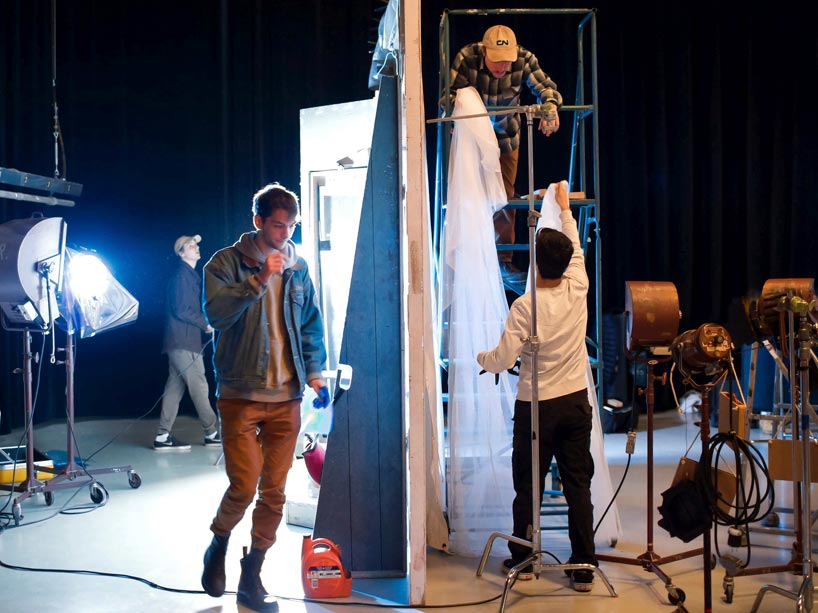
Image arts students work on stage production. From left: Jared Wallace, Ian Filipovic, Adam Bartley and Noah Lalonde. All photographs by Carlos Osorio.
Kazik Radwanski (Image Arts ’08) is midway through shooting his third feature film, but is cagey about the details. Don’t worry, the shoot is going fine — it’s just that the movie will take a little while to grow into itself.
“I hate pitching it,” says Radwanski, cheerfully, at the office he shares with his producing partner Daniel Montgomery (Image Arts ’08). “The whole film’s complex…I’ve pitched it a lot, and I’m trying to think of a good way to pitch it while omitting certain things…”
Despite the tectonic shifts that have occurred in the film industry, pitching remains a stubborn part of the process. So, Radwanski obliges. Broadly, the plot involves a woman with a complicated mental health history who works in a daycare centre — or at least that’s how it began.
“But as we’ve been making the film,” says Radwanski, “I’ve just been gravitating more and more towards keeping her backstory a mystery — not pinning down exactly what is going on with her. So, I’m very hesitant to just give an easy explanation of it.”
Other details: he is shooting at his mother’s daycare, with the 200 untrained children starring alongside actress Deragh Campbell in a realist style that rubs up against documentary. He imagines the film as the third in his loose trilogy of prickly, sandpaper-funny character studies. The first, Tower (2012), followed a 34-year-old man-child who sees little reason to leave his parents’ basement. The second, How Heavy This Hammer (2015), was about a middle-aged family man who abruptly leaves his wife, but can’t escape his ennui. These are difficult characters, and Radwanski’s films focus on them single-mindedly, almost entirely in close-up. Trapped with them, your distaste may evolve into a more complex mix of empathy, pity, recognition, and/or identification.
Radwanski defines the principle behind his minimalist aesthetic as “trying to capture moments that transcended budget” — in other words, both good art and good business. His emergence as a filmmaker has coincided with a time of enormous change in the industry: the advent of digital video has democratized filmmaking, but has also led to a saturated market where budgets have shrunk. Today’s young filmmakers have to be resourceful, adaptable and imaginative.
Radwanski’s DIY ethos is shared by a new generation of Toronto-based, millennial-age filmmakers, including some who are Ryerson image arts alumni: Sleeping Giant by Andrew Cividino (graduated ’06), Closet Monster by Stephen Dunn (’13), Fire Song by Adam Garnet Jones (’07), Cardinals by Grayson Moore and Aidan Shipley (’14), The Rainbow Kid by Kire Paputts (’07), Acres by Rebeccah Love (’14), and Firecrackers by Jasmin Mozaffari (’13). Beyond the director’s chair are producers like Caitlin Grabham (’13), Kevin Kriskst (’07), and Karen Harnisch (’09), and dozens of editors, screenwriters, cinematographers, and other creatives. All have been shaped by the new realities of production and distribution. All formed close and lasting creative partnerships during their time at Ryerson.
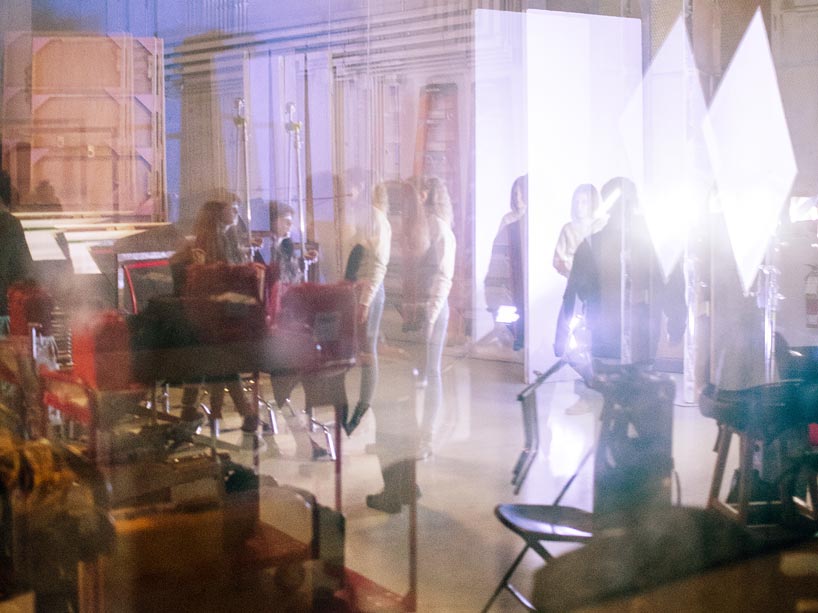
Second-year students set up a scene from Addams Family Values in their cinematography and lighting design class.
Where storytelling begins
Before you can reinvent a medium, you need to learn your craft. That’s where Ryerson comes in.
“The practice of filmmaking is still fundamentally about storytelling,” says Alex Anderson, professor at the School of Image Arts, who has worked with many of the young filmmakers. “Technology isn’t why these filmmakers are where they are. I do think the new technologies have given them more opportunities, but if you learn and practice the fundamentals of storytelling, you can easily traverse to all these other forms. What you need to know is how to write scripts, how to direct films, and how to shoot films.”
At the School of Image Arts, first-year film studies students are still required to shoot, edit and process a short movie on 16mm film. Such an exercise might seem counterintuitive in the digital era. But in addition to showing students the beauty of celluloid film, the exercise instils in filmmakers a rigorous sense of discipline.
“Working on these 1940s Bell & Howell 16mm cameras is the definition of cumbersome,” says Andrew Cividino, director of Sleeping Giant. “But the constraints were what allowed us to learn. You had to be meticulous in planning a scene. Same with the edit: you couldn’t have the luxury of your computer to non-destructively cut a frame here and there. You had to make strong decisions.”
Image arts also grounds students with a background in design, art history and cultural studies. “It gives you a blanket of knowledge about what art has meant to the world,” says Aidan Shipley, co-director of Cardinals. “It’s a huge topic to cover, but I certainly see that as one of the elements that Ryerson has that other film schools don’t. It helps contribute to the freedom you have as a third- or fourth-year filmmaker. You’ve learned that a film can be anything — a story can be told a million different ways. It opens up a sense of freedom in what people can pursue.”
One of the major advantages of film school is the resources it provides. “I was very aware of the fact that we had a soundstage here, and that was huge,” says Rebeccah Love, director of Acres. “When you’re at school, you want to take advantage of the resources at hand. One of my favourite movies of all time was Moulin Rouge, so especially with my thesis film, I wanted to take advantage of the soundstage and the labour you have access to. You have access to all of the younger-year students who volunteer on your set, to the point where you have a crew of 60 people on your film, which you can’t have when you’re outside of film school.”
Alumni say the biggest advantage of school was connecting with like-minded peers. Examine the crews of their debut films and you’ll find almost entirely Ryerson alumni — from cinematographers to editors to producers to performers.
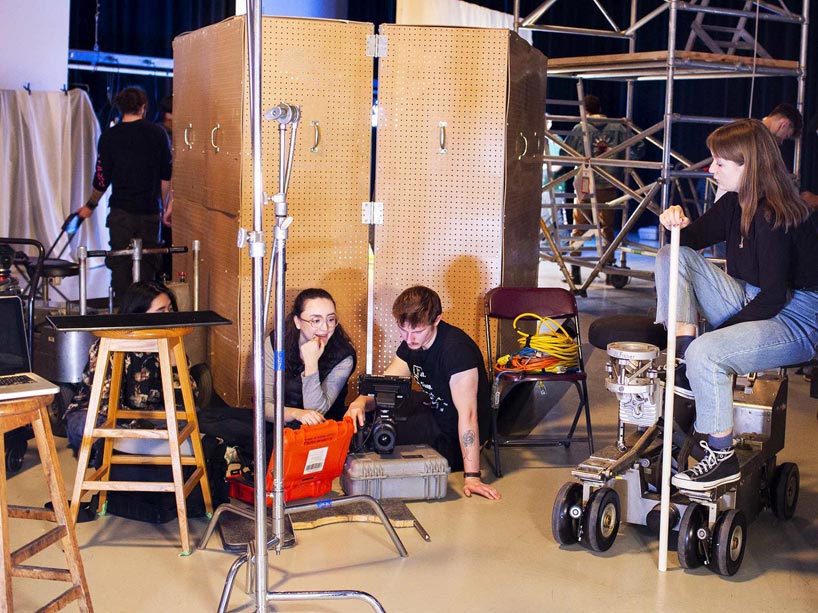
Students Sofia Powell, Matt Hampel and Emma Robinson on set in professor John Tarver’s cinematography class.
“When you’re working in film, it’s such a collaborative space — it’s so important to trust and believe in the people you work with,” says Cividino. “Film school is a really wonderful place to find that. You work with people who you don’t necessarily connect with, but when you find the people you do, you sort-of hold on to each other for dear life. When you’re in the thick of filmmaking, those are the people you can trust to tell your stories.”
“Every assignment you make, you put on a screen in front of your peers, and everybody critiques it,” remembers writer/director Jasmin Mozaffari. “You have to get used to that. But then you end up self-critiquing, and you always end up setting the bar higher.”
Beyond finding a network, school is a place to find your voice. Mozaffari was enrolled in another university’s film studies program when she realized that her passion was to make films. When she transferred to Ryerson, she had never made a film before, and the four-year program was a process of discovery.
“We were doing small documentaries, shorts. I was editing, I was trying out different things. I always knew I wanted to be a director. I was trying to find out what is my voice.” In her fourth year, she directed a short that would become the basis for her acclaimed 2018 feature Firecrackers.
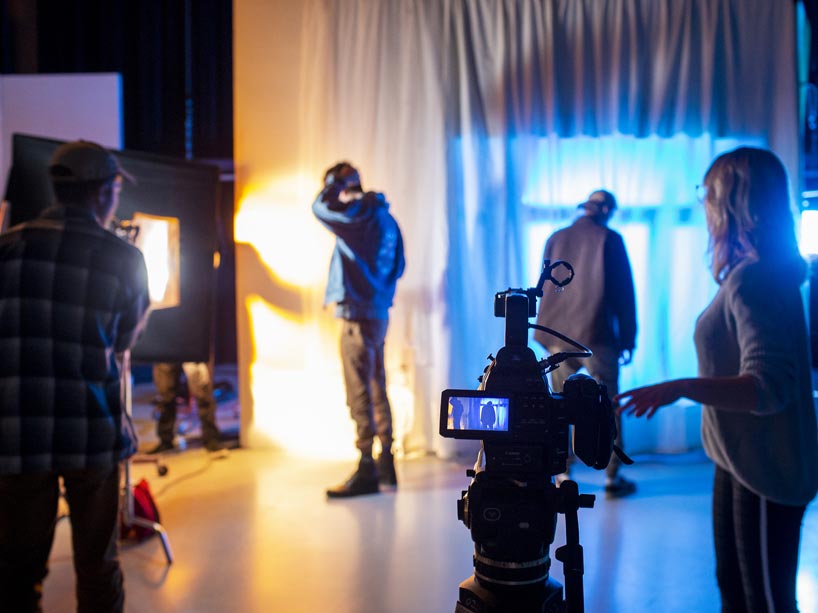
Did you know the School of Image Arts has a movie studio?
Life after film school
At some point, all student filmmakers will have to reckon with the reality of filmmaking outside of school. Radwanski and Montgomery came upon their style early when they travelled to Kenya between third and fourth year to make Nakuro Song, a documentary about a soccer team. “It really informed the way we were working at the time, and in many ways how we’re still working today,” says Montgomery. “There were only three of us there, and we only had as much gear as we could carry, and we just relied a lot on a certain documentary aesthetic to keep things nimble and light. We enjoy working with a very small crew.”
The large-scale productions that Rebeccah Love mounted for her student films were no longer possible after graduation — but starting over led her down a new path. “I didn’t have access to the resource of the soundstage anymore, and I didn’t have budgets to hire 60 to 80 people. That’s where my style changed. I made a film called Drawing Duncan Palmer working with a Ryerson cinematographer, Eric Rowe. We didn’t have money to make a big, over-the-top production, so we made a film that was very minimalist, with no production design budget, using natural lighting.”
Cividino’s first feature benefited from its modest budget. “I think that although Sleeping Giant would have been easier to make with a substantial budget, it would have been a worse film. It was the freedom to make it the way we wanted to that gave it the heartbeat it has.”
Critics and programmers around the world agreed: Sleeping Giant premiered at the 2015 Cannes Film Festival in the Critics’ Week competition before playing at the Toronto International Film Festival and earning four Canadian Screen Award nominations. An unsentimental evocation of the awkwardness of adolescence, Sleeping Giant follows three kids during a tense summer vacation on the shores of Lake Superior as they struggle with their friendships, families and budding romantic feelings.
“When you’re working with a larger budget, with a larger crew, you’re free to increase the scope of your project in some ways, but you’re much more limited in terms of steering the ship,” says Cividino. “You can’t just decide, ‘I want to do this shot,’ or spend three days workshopping a scene. Everything costs a lot more money on a larger scale, and that means you essentially have to go in with a plan and execute it.
“Whereas, a lower budget level, although it has many of its own constraints, allows you the freedom of employing a process that encourages exploration. I think there’s a lot of freedom that comes with the DIY atmosphere that you’re finding in the Toronto scene,” says Cividino.
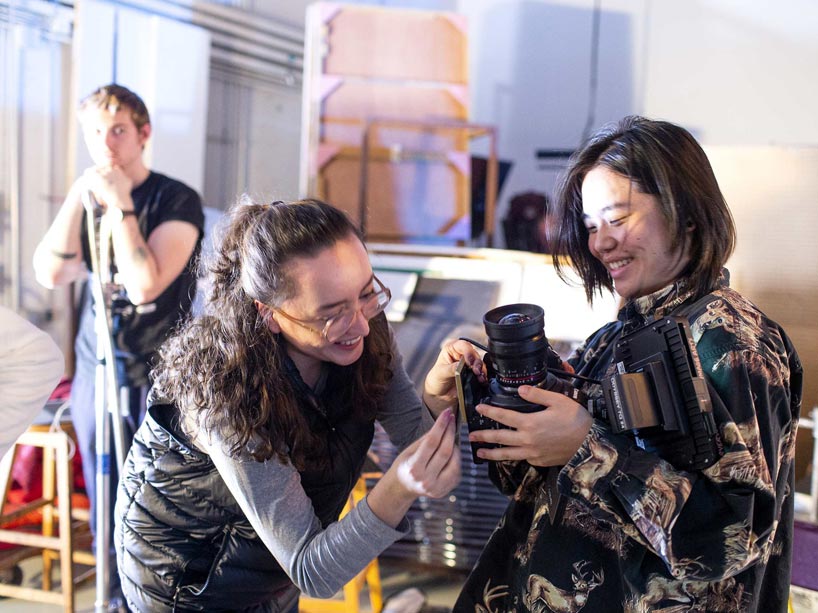
Students Matt Hampel, Sofia Powell and Ezra Li in cinematography class.
A tool for activism
Cinema can be a source of entertainment, but it can also be a tool for activism. The democratization of filmmaking has made it possible to tell stories that were once hidden from view.
Susan Enberg, (master’s) documentary media ’17, was researching Canada’s residential school system when she learned about St. Anne’s Residential School in Fort Albany, Ont., where some of the system’s worst atrocities took place. She learned of the sexual, physical and psychological assaults; of the homemade electric chair that was used for punishment; and of how little the survivors had been compensated. Their stories are the foundation of In Jesus’ Name: Shattering the Silence of St. Anne’s Residential School, the first in a series of documentary films – Erasing Cultural Genocide – about St. Anne’s and its survivors.
“Without the courage of the survivors, and their willingness to speak out about what they endured at the school, people in Canada would still not truly know the depth, breadth and severity of the abuses that occurred at the schools,” says Enberg. “Many people had become more aware of the Truth and Reconciliation Commission and what its admissions were. When our film came out, people really paid attention. People want to know.”
Enberg came to filmmaking via a different route than the aforementioned directors. A mature student and single mother, Enberg devoted most of her career to human rights issues, and saw documentary filmmaking as a chance to bring her activism to an audience beyond academia. As a survivor of abuse, and someone whose Métis heritage was largely hidden from her growing up, her documentary has personal significance.
Despite the importance of her project, its status as a student film made it ineligible for public arts council grants. “A lot of documentary filmmakers make promises to pay people in the future when they start making money, and I don’t agree with that,” says Enberg. “When somebody’s doing a task for me, I pay them, so I made sure I paid my crew all the way through—while I was a student. It came out of my OSAP, it came out of my child support, it came out of my daily meal allowance for my family.”
For In Jesus’ Name, Enberg didn’t have the luxury of a low budget. “I had to go into a fly-in community with a crew, and we were there for three-and-a-half or four weeks altogether. I had to house everybody, feed everybody — the only people that jumped to our assistance was the Office of the President of Ryerson.” Within 12 hours of writing then-president Sheldon Levy, Enberg received $10,000 for travel to Fort Albany.
In Jesus’ Name won many awards on the festival circuit, was picked up by CBC Documentary channel for a three-year contract, and a segment has been installed at the Canadian Museum for Human Rights. Screenings at festivals and institutions have featured Q&As with Enberg alongside St. Anne’s survivors Louis Knapaysweet and Edmund Metatawabin. Enberg is currently at work on two new films: Fight Like a Woman (a short documentary about female Muay Thai fighters) and 8 ½ Seconds (about the police-shooting death of Michael MacIsaac in Ajax).
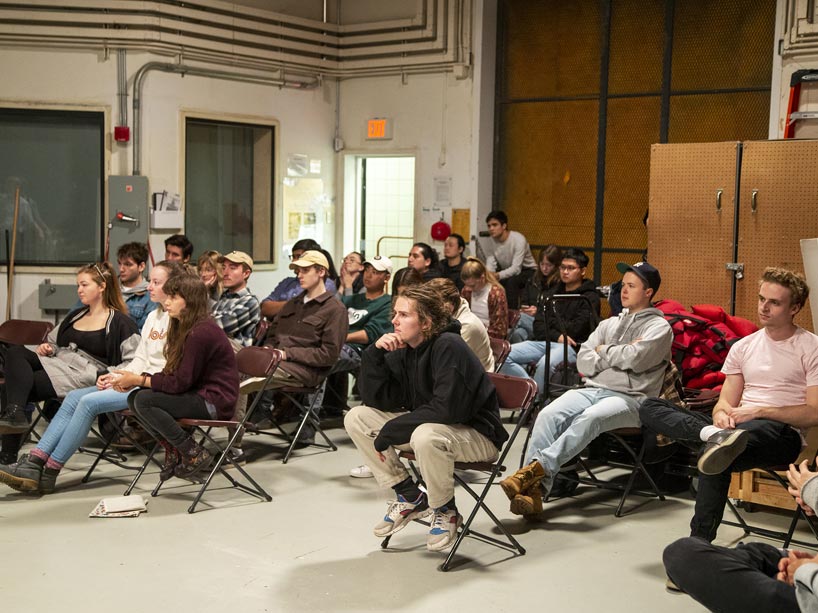
A second-year cinematography class at Ryerson.
Toronto’s first wave
In the 1980s, Ryerson was a breeding ground for the first cohort of “Toronto New Wave” filmmakers. The bonds formed by film students like Bruce McDonald (’82), Jeremy Podeswa (’84) and Adrienne Mitchell (’84) could be felt as they moved through the industry.
The waves are cyclical, and today’s second wave are actively fostering incoming generations. After graduating from Ryerson, Rebeccah Love pursued a master’s degree in screenwriting at the University of Guelph, where students were matched with mentors to work alongside in the summer. Her mentor was Kazik Radwanski. “He had emerged as this giant of independent filmmaking in this city,” she says. “I thought: How great would it be to be matched up with him and learn filmmaking from him? We started meeting up once a week for coffee, and in these sessions, he gave me feedback on a number of scripts, including the script for Acres.”
With their first string of films completed, this group of the Toronto New Wave are now looking ahead at future projects. Aidan Shipley recalls the 2017 TIFF premiere of Cardinals as being a watershed moment. “It was totally overwhelming. I feel like I blacked out for a couple of days — and the alcohol wasn’t fully responsible for that, either,” he says. “But from the people I was able to meet through that, I feel I can go develop any project now through one connection or another I made at TIFF.” He is now producing a documentary on childhood sexual assault called A Girl Named C.
Since the success of Sleeping Giant, Andrew Cividino has made a living as a director through TV and commercial work, and at the time of this interview, he was casting his second feature (which had just secured financing), writing his third, and developing a sci-fi drama series for television. “I’ve learned that it’s important to have many irons in the fire, because the timing is often out of your control,” he says. “It’s a miracle that anything gets made, and even more so that anything good gets made.”
Are things easier now? “I would love to say it has gotten a lot easier, but it has just gotten different,” says Cividino. “The opportunities that I’ve been presented with have been great, and increased, but you’re just faced with new challenges. I think filmmaking is an inherently challenging process, and maybe the moment you stop being challenged is the moment you stop making interesting work, anyway.”
Meanwhile, at the School of Image Arts, the next generation is always underway — and Ryerson offers a range of scholarships to foster it. “We’re not an ivory tower in image arts,” says Alex Anderson. “We aren’t a separate place from the real world. We’re really doing what we can to support the Canadian film industry. It’s a huge leap to become a professional, but I see us as a cauldron. Talent, ideas… that’s our job.”
This story appears in the January edition of the Ryerson University Magazine. Read the whole issue (external link) online: It's available as an accessible digital edition (external link) , and a mobile edition (external link) .